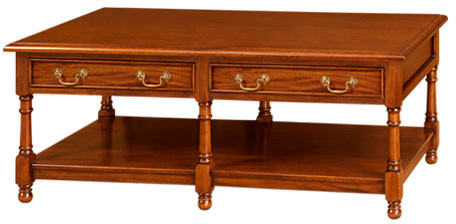- Home
- Learn About Antique Furniture and Reproductions
- Resources
- Why Mortise and Tenon Lasts So Long
Why Mortise and Tenon Lasts So Long

Roughly in the 12th century, Chinese woodworking artisans perfected an ancient joint that is still used today. This joint allows us to maximize gluing surfaces while also permitting a more mechanical approach to joint making. A finger (called a tenon) is milled and thus fits into a hole (mortise). A typical mortise and tenon joints feature all four edge and face surfaces of the tenon to slip snugly against the walls of the mortise, creating a powerful bond for project parts—from buildings to structures and furniture.
The early Chinese craftsmen used mortise and tenon joinery to construct buildings at that time, not just furniture, but the principle of the joint remains the same regardless.
Today, there are many variations of the mortise and tenon joints, but the basic joint itself is composed of two components:
- The mortise hole
- The tenon tongue
The tenon, formed on the end of a piece of wood generally referred to as a rail should fit into a square, or rectangular hole cut into the other corresponding piece of wood. There are usually shoulders cut into the tenon piece that seat when the joint fully enters the mortise. Once this happens, the joint can be wedged, glued, or pinned to be locked in place.
To build a solid, long-lasting mortise and tenon joint requires precision. If applying glue, a craftsman must leave enough space for the glue. Too narrow a tenon, there is no friction to resist tension and little to no surface to surface contact for a good glue joint. Too thick, and there is a very large risk the joint could be blown apart when wood naturally expands. A strong joint that will last and be able to bear weight must fit snugly into the mortise along the width of the timber. It should take some hand pressure to fit the tenon into the wood, and yet the snug fit should create the friction needed between the pieces of wood that will resist the joint from pulling apart and allow proper glue adhesion.
Why Mortise and Tenon Joinery Lasts so Long
Beams and columns in ancient Chinese buildings made from wood were connected with mortise and tenon joints, and nothing else. No nails, no glues, and no pins were used to secure these ancient structures from large to small. These joints remained semi-rigid despite the lack of adhesives due to the friction and squeezing deformation between mortise and tenon.
In Japanese traditional timber structures, one of the most typical connections which are used is a mortise and tenon with the addition of a wooden dowel, and many structures have survived seismic behavior.
The reason that mortise and tenon joinery lasts so very long is that it was and is the simplest joint to use in terms of expertise as well as the strongest. When an expert carpenter or cabinet maker creates a quality mortise and tenon joint, it becomes the perfect registration of two pieces and essential to creating heirloom pieces.
In November 2006, the Wood Magazine tested pocket screws against dowels and which of the woodworking joints gave the most strength. For that test, they created more than 100 joints and destroyed them under various stressors in issue #173.
Mortise and Tenon Shear Test
Mortise and tenon joints were able to withstand over 1,005 pounds of force, over double to triple the amount of force to break compared to other joints.
Mortise and Tenon Pull-Apart Test
Using a biscuit miter joint, it took 220 pounds of force, with a Dado, 559 pounds of force to pull apart joints. Screws used in this case did not assist in force resistance at all.
For the mortise and tenon joint, the wood failed, but the joint did not. It took 4,733 pounds of force, which is nearly 2 ½ tons, to pull the joint apart.
It becomes clear, based on the above tests, the reason why the mortise and tenon joint has been used again and again over the millennia and to this day. As one of the stronger joints a master craftsman can use in their creations, it is one of the hardiest, most long-lasting joints and arguably the best to use to create heirloom-quality furniture.
This reason is why we at Laurel Crown create our long-lasting, extremely strong, hardy, and heirloom quality furniture with mortise and tenon joints. We are seriously committed to creating furniture exactly as the masters of antique furniture would, whose creations exist still to this very day. Emulating the structure of wooden craft that has lasted through time and weathered the ages is something we strive to do with each handmade piece of furniture.









